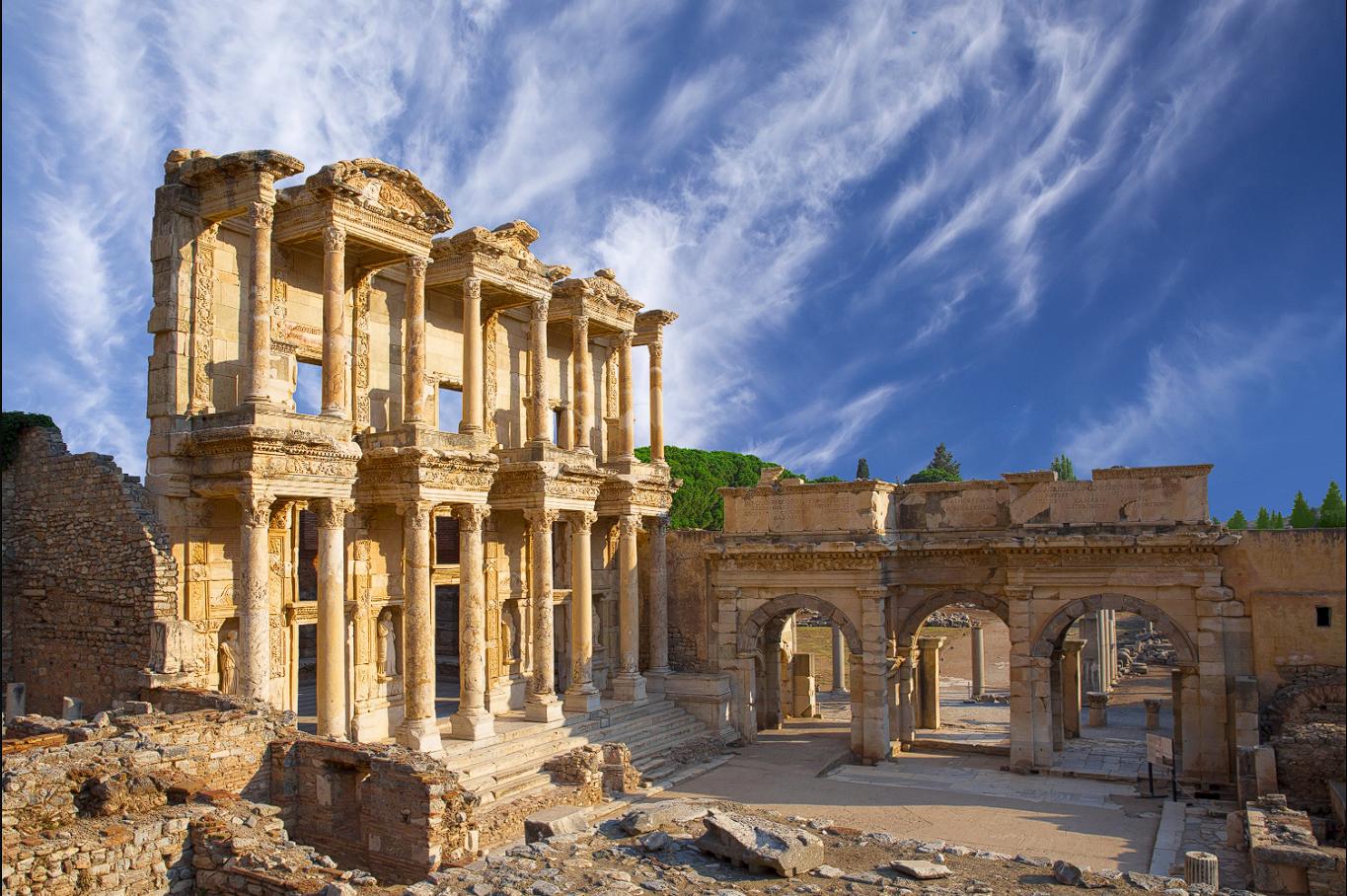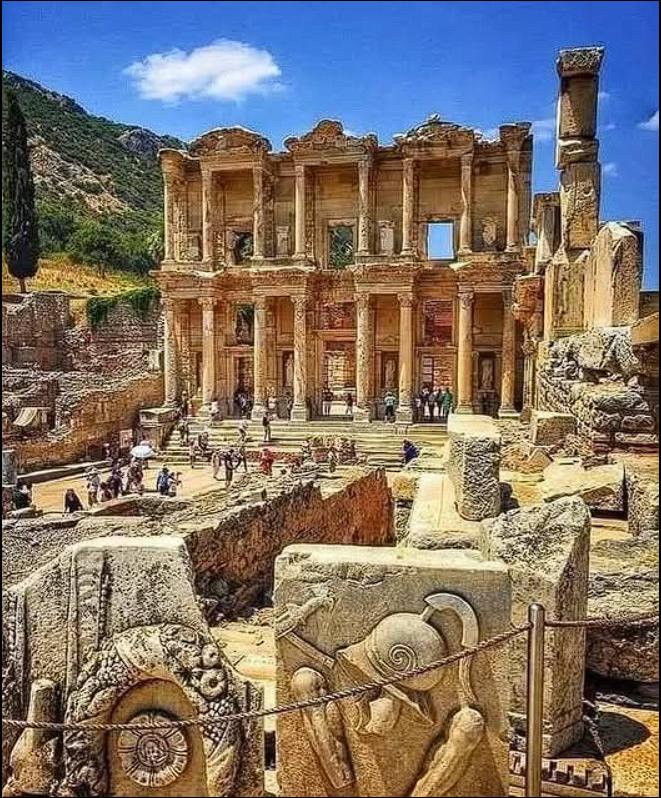“The Library of Celsus, an architectural marvel nestled within the ancient city of Ephesus, stands as a testament to the Roman Empire’s commitment to knowledge and culture. Built in the 2nd century AD, this grand structure, commissioned by Tiberius Julius Aquila in memory of his father, Gaius Julius Celsus Polemaeanus, served not only as a repository for 12,000 scrolls but also as a monumental tomb. Though ravaged by time and conflict, its restored façade continues to captivate, offering a glimpse into the intellectual grandeur of the Greco-Roman world.”
A Sanctuary of Knowledge: The Library’s Grand Design
- A Tribute to a Roman Proconsul:
- The library’s construction was a deeply personal tribute, commissioned by Tiberius Julius Aquila to honor his father, Gaius Julius Celsus Polemaeanus, a respected Roman senator and proconsul of Asia. This act of filial piety transformed a public space into a lasting memorial.
- This dedication underscored the importance of honoring intellectual and political achievements in Roman society, transforming the library into a symbol of both personal and civic virtue.
- A Center of Learning:
- With an estimated collection of 12,000 scrolls, the Library of Celsus was a major center of learning and culture in the Roman Empire. Its vast collection attracted scholars and intellectuals, fostering an environment of intellectual exchange and discovery.
- This concentration of knowledge made Ephesus a vital hub in the Roman world, contributing to the dissemination of ideas and the preservation of classical literature.
- Architectural Marvel:
- The library’s grand marble façade, a testament to Roman architectural prowess, featured Corinthian columns across two levels, creating a sense of majesty and grandeur. The intricate details and harmonious proportions of the façade reflected the Roman appreciation for beauty and order.
- This architectural masterpiece not only served as a functional space for storing scrolls but also as a visual representation of the intellectual wealth and cultural sophistication of the Roman Empire.

Symbolic Statues: Representing Virtues of the Mind
- Niches of Wisdom and Knowledge:
- The façade’s niches were adorned with statues representing the ideals of Wisdom (Sophia), Knowledge (Episteme), Intelligence (Ennoia), and Virtue (Arete). These symbolic figures underscored the values that the library sought to promote, highlighting the importance of intellectual and moral excellence.
- These statues were not merely decorative elements but integral components of the library’s symbolic language, conveying the virtues that were essential to Roman society and the pursuit of knowledge.
- Philosophical Ideals in Stone:
- The statues of Sophia, Episteme, Ennoia, and Arete represented the philosophical ideals that guided Roman intellectual life. They symbolized the pursuit of truth, the acquisition of knowledge, and the cultivation of virtue.
- These ideals, embodied in stone, served as a constant reminder of the library’s mission to promote intellectual and moral development, shaping the minds of those who entered its halls.
- A Tomb and a Library:
- The library’s dual function as a tomb for Celsus added another layer of significance. His sarcophagus, placed beneath the building, transformed the library into a monumental memorial, linking the pursuit of knowledge with the commemoration of a respected citizen.
- This dual purpose highlighted the Roman belief in the enduring power of memory and the importance of honoring those who contributed to the intellectual and cultural life of the empire.
A Legacy of Grandeur: Echoes of Ancient Scholarship
- Destruction and Restoration:
- The library’s destruction by fire during a series of earthquakes and invasions in the 3rd century AD marked a tragic loss for the ancient world. However, its beautifully restored façade continues to captivate visitors, offering a glimpse into its former grandeur.
- This restoration, a testament to modern archaeological efforts, allows us to appreciate the architectural and intellectual achievements of the Roman Empire.
- A Window to the Past:
- The Library of Celsus serves as a window into the intellectual and cultural life of the Greco-Roman world. Its grand façade and symbolic statues offer a tangible connection to a bygone era.
- Its enduring presence allows us to imagine the scholars and intellectuals who once walked its halls, seeking knowledge and wisdom within its walls.
- Enduring Influence:
- The library’s legacy extends beyond its physical presence, serving as a symbol of the enduring power of knowledge and the importance of preserving cultural heritage.
- Its story continues to inspire, reminding us of the vital role that libraries and centers of learning play in shaping civilizations.
Conclusion:
“The Library of Celsus, a monument to knowledge and a testament to Roman architectural elegance, stands as a powerful reminder of the intellectual grandeur of the ancient world. Its grand façade, adorned with symbolic statues, and its function as both a library and a tomb, highlight the Roman commitment to learning and the enduring power of memory. Though ravaged by time, its restored presence continues to captivate, offering a glimpse into the intellectual and cultural legacy of a civilization that valued knowledge and celebrated its pursuit.”

CÁC TIN KHÁC
Mary Walton: The Forgotten Inventor Who Helped Clean Up America’s Cities
Tomb of Queen Nefertari in the Valley of the Queens, Egypt
Discover the Hypostyle Hall of the Temple of Hathor at Dendera
Venus de Losange: Unveiling the Mystery of a 20,000-Year-Old Paleolithic Icon